The Nikon 1 J1 camera and several lenses for it were provided by Oneschuk Vadim for review.
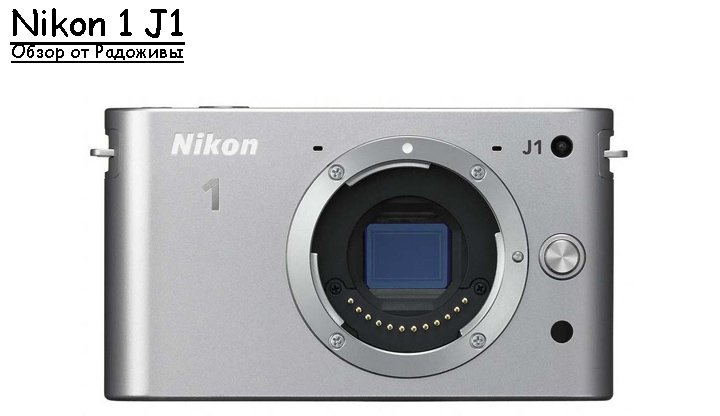
Review of the Nikon 1 J1. It looks like Nikon J1 without a lens (body)
The Nikon 1 J1 is one of six (2013) 'Nikon 1' interchangeable lens mirrorless cameras. The Nikon 1 J1 has a 'Nikon 1' mount and, for the first time since 1960, Nikon has released a range of non 'Nikon F' mount cameras. On sale you can find both Nikon 1 J1 Body (a camera without a lens) and Nikon 1 J1 kit (a camera with one or more lenses). The Nikon 1 J1 has a simple menu that anyone can understand. Shooting with a camera in automatic mode is very, very easy. But for professional use, the Nikon J1 is no good.
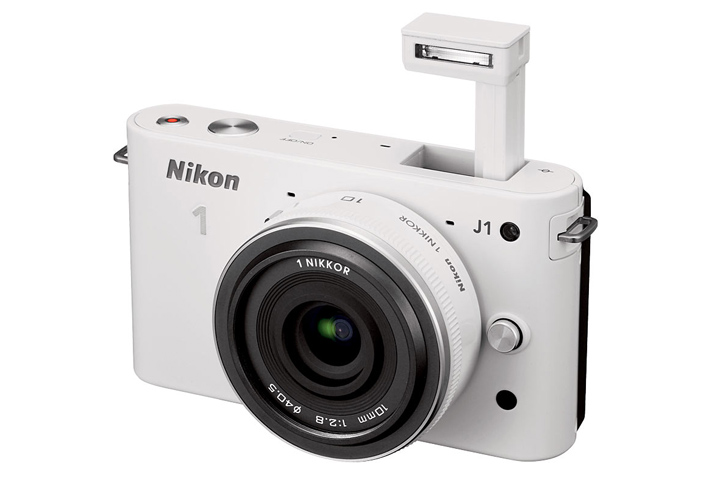
Nikon 1 J1 with fixed lens 10mm 1: 2.8 1 Nikkor. The camera can be of different colors.
Lenses
Fix Lenses:
- Nikon 1 NIKKOR 10mm f / 2.8 (black and silver)
- Nikon 1 NIKKOR AW 10mm f / 2.8 (only black)
- Nikon 1 NIKKOR 18.5mm f / 1.8 (black, silver, white)
- Nikon 1 NIKKOR 32mm f / 1.2 (black, silver)
Zoom lenses
- Nikon 1 NIKKOR VR 6.7-13mm f / 3.5-5.6 (black and silver)
- Nikon 1 NIKKOR VR 10-30mm f / 3.5-5.6 (8 color options)
- Nikon 1 NIKKOR VR 10-30mm f / 3.5-5.6 PD-ZOOM (6 color options)
- Nikon 1 NIKKOR VR 10-100mm f / 4-5.6 (5 color options)
- Nikon 1 NIKKOR VR 10-100mm f / 4.5-5.6 PD-ZOOM (only black)
- Nikon 1 NIKKOR 11-27.5mm f / 3.5-5.6 (6 color options)
- Nikon 1 NIKKOR AW 11-27.5mm f / 3.5-5.6 (black, silver, white)
- Nikon 1 NIKKOR VR 30-110mm f / 3.8-5.6 (8 color options)
- Nikon 1 NIKKOR VR 70-300mm f / 4.5-5.6 N (only black)
For myself, I would take a bunch of universal lens Nikon 1 NIKKOR VR 10-100mm f / 4.5-5.6 PD-ZOOM and portrait lens Nikon 1 NIKKOR 32mm f / 1.2, however, such a set will be quite expensive :). It's very funny that Nikon released Nikon 1 NIKKOR 32mm f / 1.2but still not updated to the autofocus version of the old Nikon 50mm 1: 1.2 AI-S.
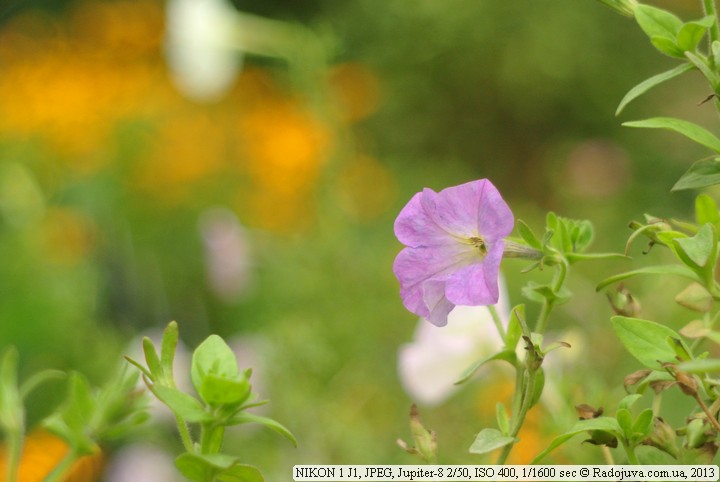
Example photo on the camera and lens Jupiter-8
There is a special list of Nikon FX, DX lenses that you can easily use on your Nikon 1 J1 camera using the FT1 adapter. More details about this issue can be found in the section on Nikon CX Lenses.
Nikon 1 J1 has a very short working length, which allows you to use many manual lenses from rangefinder cameras. But here's the trouble - Nikon 1 J1 the possibility of measurement is reduced exposure with old uncoupled optics. You can shoot with manual lenses only in 'M' mode. Modes P, A, S, M must be selected in the camera menu 'Exposure mode'.
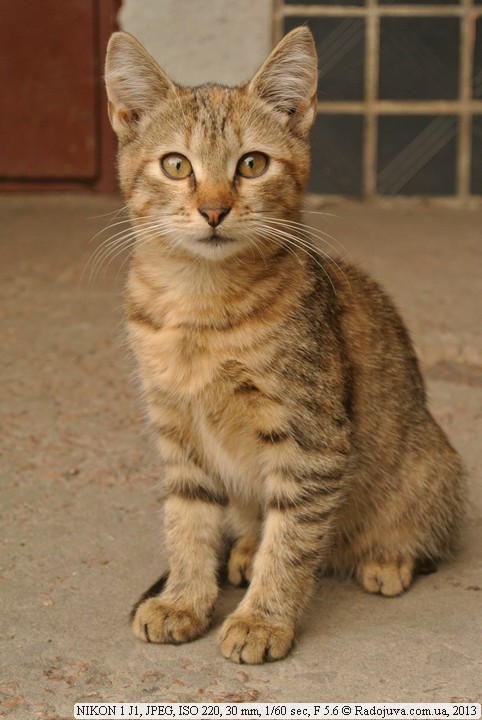
Cat on Nikon 1 J1
Matrix
Nikon 1 J1 is a tiny system camera with crop factor 2.7X. This means that matrix size Nikon 1 J1 7,3 times smallerthan any film (135th film) or any full-format camera. Matrix size plays a huge role in the construction of the image. Nikon 1 J1 sensor with a nail - 13.2 x 8.8 mm... On such a small (in physical size) matrix, 10.0 megapixels were placed. Most likely, marketing played here, because anything less than 10 MP, nowadays already causes a malicious grin. In this way, the camera can take pictures of 3,872 x 2,592 pixels (exactly 10 pixels). 036 MP - this is quite enough for amateur tasks, for example, with 224 MP you can print A10 images without any problems. In order not to bother about the number of pixels, I advise you to look at the article ' Battle of Megapixels '.
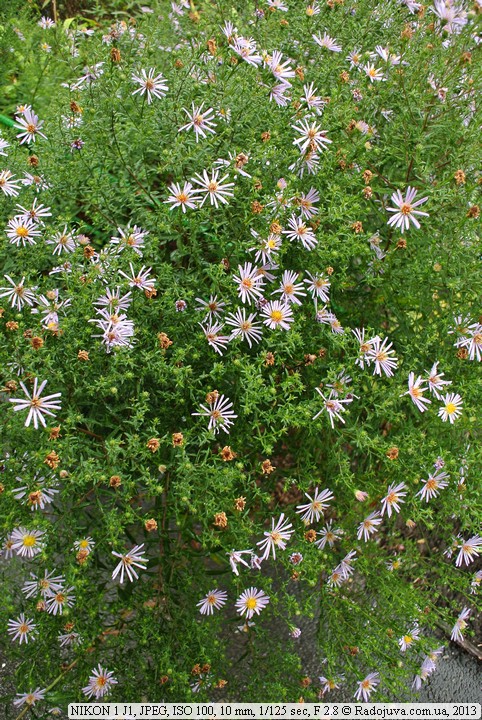
Sample photo on Nikon 1 J1 for fast fix
By the way, 3 more cameras of the Nikon 1 series use the same CMOS sensor - this is Nikon 1 J2Nikon 1 S1Nikon 1 V1. Nikon 1 J1 can use ISO from 100 to 3.200 and expand to a value of 6.400 (ISO HI 1). The camera has three auto ISO modes:
- A3200 - Uses ISO 100-3200 range
- A800 - Uses ISO 100-800 range
- A400 - Uses ISO 100-400 range
True, automatic ISO selects not the most successful excerptsmost likely focusing on the focal length of the lens (Golden Rule) So, the camera often gave me a shutter speed of 1/30 s, while I could take a picture of stationary objects without problems, but people were already blurry for 1/30 of a second.
The lower the ISO level, the less noise you can get in photos. Nikon J1 is comparable in noise level to old SLR cameras Nikon D40, D70s (noise starting from ISO 200). A miracle did not happen, and at ISO 3200 I get a good image, but the noise reduction function removes image detail. Here original shot at ISO 3200, in the photo due to the noise reduction algorithm, the cat's face became similar to Vrubel paintings. But in any case, the picture from the Nikon 1 J1 looks decent.
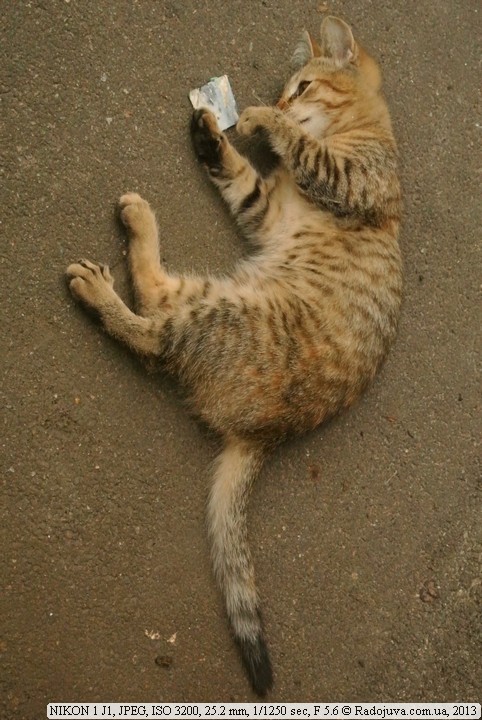
Sample photo on Nikon 1 J1 at high ISO. The cat is playing.
Nikon 1 J1, unlike mirrorless cameras Sony Nex and many others, does not have a mechanical shutter. During shooting, there is no excess noise from the movement of the shutter shutters. Also, the iris control mechanism is built into the Nikon 1 lenses themselves and is very quiet. Focusing with Nikon 1 lenses is also very, very quiet.
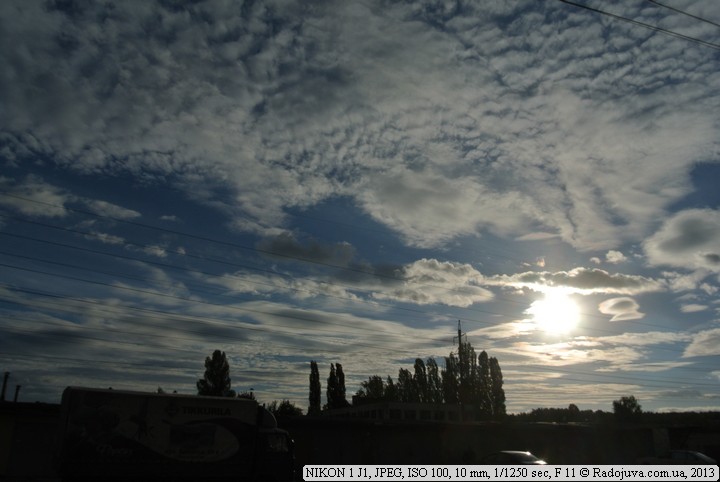
Cat on Nikon 1 J1
Very important points in the Nikon 1 J1 camera:
- the camera can use an ultra-fast shutter speed equal to 1 / 16,000 seconds. Among Nikon SLR cameras, only Nikon D1x, D1h, D1.
- the camera has neither optical nor electronic viewfinder. You can only zoom in using the camera display. A camera display 3-inch, TFT LCD type at 460.000 points.
- the camera has a built-in flash that shoots (rises) upward when you press the corresponding button. By the way, the flash works pretty well.
- There is also an auxiliary focus auto focus light, which lights up in green.
- remotely control the camera using a cheap remote control ML-L3.
- the camera has a USB output and mini type C HDMI.
- camera supports memory cards SD, SDHC, SDXC (and UHS-I).
- The battery is powerful enough, I had about 500 photos per charge.
- the camera has a sleep mode, the time after which the camera goes into this mode is configured.
- the camera has features that enhance the picture: Active D-lightning, noise reduction at high ISO and slow shutter speeds.
- the camera can be connected to an outlet using an EP-5C cable. For the camera, there is even a special GR-N2000 handle for a comfortable grip (not to be confused with the booster).
- the camera has an interesting 'Motion Snapshot' mode, during which a short video is recorded at a high frame rate per second and a photo is taken in parallel.
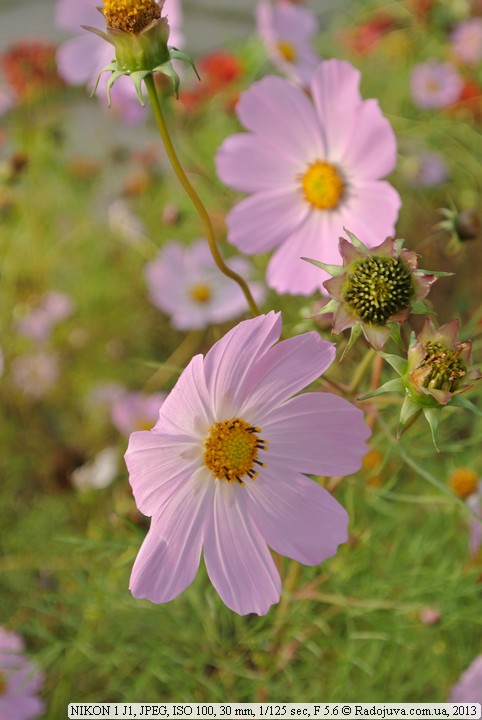
Flowers on Nikon 1 J1
Camera performance
Nikon 1 J1 weighs a little less than 300 grams, a camera with a small lens can even be placed in a jacket pocket. The camera body is made of aluminum alloy.
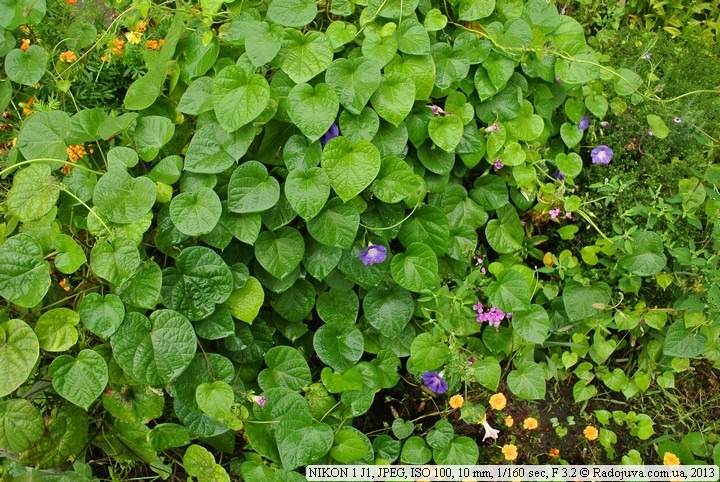
Sample photo on Nikon 1 J1
And now the fun part is this baby can take off photo at a speed of 60 (sixty) frames per second! This is an outrageous indicator. At what you can shoot 60 fps with any parameters, even RAW + JPEG. However, a serious drawback of such super-fast shooting is the very small frame buffer. The processor is responsible for image processing EXPEED 3, the same as Nikon D800, D7100.

Photo at Nikon 1 J1
Buffer:
- 12 frames in the shooting mode 'Continuous -> Electronic (BC)' with a frequency of 30 or 60 fps, moreover, with any quality settings, the buffer is always exactly 12 frames. This means that only 60/1 of a second can be shot at 5fps. At 10 fps, the buffer becomes 13 frames.
- 17 frames in JPEG, L, Fine. With this function ADL, noise reduction at high ISO, noise reduction at long exposure, auto ISO - off.
- 23 frames in JPEG, L, Fine mode, if you also switch to M mode in addition.
- 83 frame in JPEG, S, Basic mode and all disabled functions
- 14 frames in JPEG, L, Fine mode or in RAW mode or in RAW + JPEG mode with all additional functions enabled
Frame buffer turned out to be quite capacious, it's a pity you can't put 83 frames at 60 fps. In other modes, the camera can shoot at speeds up to 5 fps. And in the 'Electronic (BC)' mode, you can set 10 or 30, or 60 c.s. RAW files have 12-bit color depth and weigh an average of 10 MB. JPEG L Fine weighs an average of 5 MB.
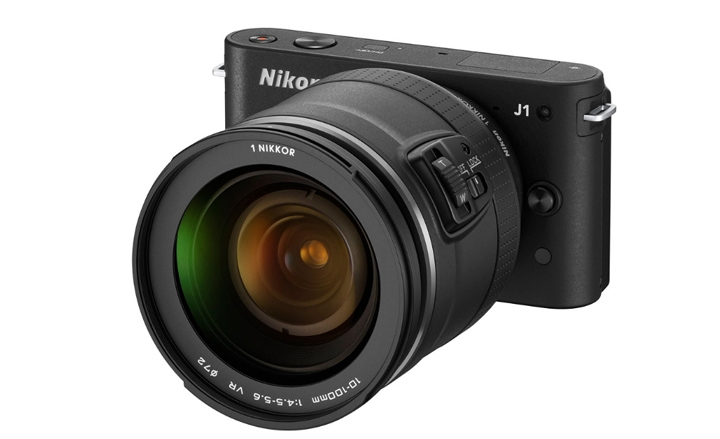
Nikon 1 J1 with super zoom
Focusing
Focusing on the Nikon 1 J1 is fast, several modes are available. You can select one focus point and know exactly where the camera focuses. In manual focus mode, you can enlarge any area of the image, but only the increase is not available when working with manual optics.
Nikon 1 J1 uses a hybrid focus method. Focusing in video mode is also fast, so the Nikon 1 J1 outperforms its mirror counterparts, where there is a serious problem with focusing speed. Typically, SLR cameras for video use contrast focusing, which is why focusing is very, very slow, even on very expensive cameras.

Nikon 1 J1 rear view
Video
A very strong point of the Nikon 1 J1 is the video. The camera can take Full HD at 60 frames per second... MPEG4 Video (H264) 1920 × 1080, AAC 48000Hz stereo 128Kbps codec in MOV container. You can also shoot at 1920 × 1080 30p or 1280 × 720 60p.
And the camera has two slow motion modes:
- 640 x 240 400 frames per second
- 320 x 120 1.200 frames per second
Just think - 1200 frames per second, while you can make really interesting videos. The movie itself is played at standard 30 frames per second, and it turns out 40-fold slowdown. The camera also has stereo microphone to record video. In aperture priority mode, aperture changes are available during movie shooting. In M mode, you can control and shutter speed and diaphragm, such a complete control of these two parameters is only in the very expensive CZK Nikon D4, D800,D800E.
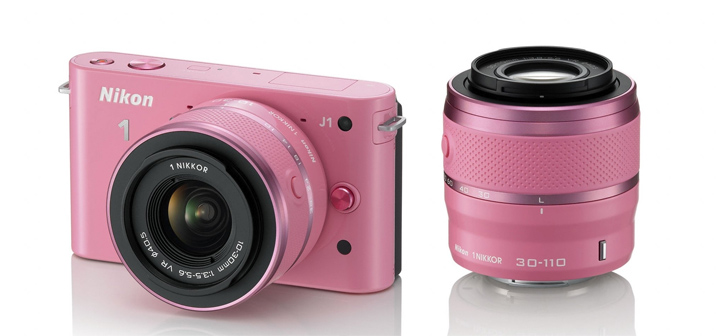
pink Nikon 1 J1 camera, you know for whom
Lenses
I used two native lenses - 1 Nikkor 10mm 1: 2.8 RF Aspherical и 1 Nikkor 10-30mm 1: 3.5-5.6 VR IF Aspherical... The lenses are very small, compact, with internal focusing. Focusing itself is fast. The lenses do not have a diaphragm control ring, focusing ring, focusing distance scale, depth of field scale, they have nothing at all :). The lens aperture is controlled by a mechanism built into the lens itself. The number of aperture blades in lenses is 7 pieces. In the removed position, the lens aperture is completely closed. The MDF lenses are 20cm and use a tiny 40.5mm filter. You can buy a lens hood for the lenses.
1 Nikkor 10-30mm 1: 3.5-5.6 VR - stock lens with stabilization. Has an interesting zoom latch. In the inactive position, the lens trunk is hidden. You need to zoom manually, like with any lens from a SLR camera. The zoom button can automatically turn on the camera. The lens has a metal mount. Weighs 1 Nikkor 10-30mm 1: 3.5-5.6 VR 115 g. Minimum aperture is f / 16. The lens can catch glare in backlighting.

Optical design of the 1 NIKKOR VR 10-30mm f / 3.5-5.6 lens
You can look at the real prices for 1 Nikkor 10-30mm 1: 3.5-5.6 VR lens in popular online stores at the following links:
Prices for modern lenses for the Nikon 1 system can be found here.
1 Nikkor 10mm 1: 2.8 RF Aspherical - fast wide-angle lens. Weighs 77 grams. Instead of a focus ring, it has a 'snag'. The minimum aperture is F / 11. The mount is metal.

Optical design of the 1 NIKKOR 10mm f / 2.8 lens
You can look at the real prices for the 1 NIKKOR 10mm f / 2.8 lens in popular online stores at the following links:
Prices for modern lenses for the Nikon 1 system can be found here.
There are no serious comments on image quality for lenses. I do not plan a detailed review of these lenses, since there is practically nothing to view. Examples of photographs on lenses:
Photo parameters: on-camera JPEG L Fine without processing. All shot in Picture Control mode SD and VI. Used white balance: 'Auto', 'Shadow', 'Direct Sunlight' and 'Cloudy Sky'. Photos have been resized to 2048px by 1363px Q = 85% (about 3MP). More photos from Nikon 1 J1 can be found in Jupiter-8 2/50 review.
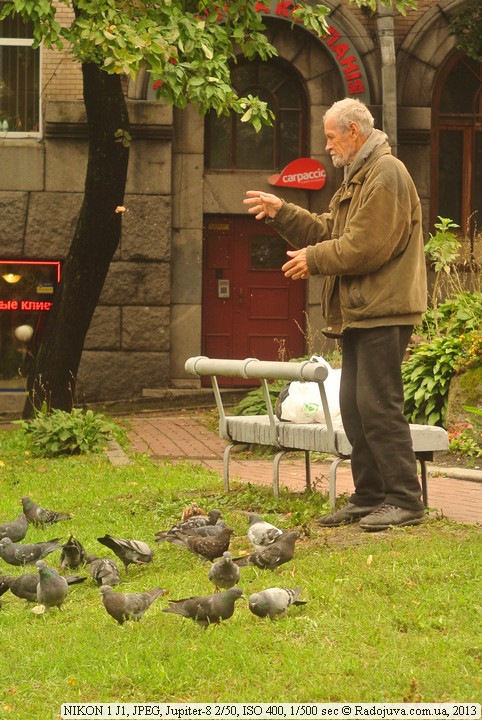
Photo on camera
Personal experience
I was extremely uncomfortable using the Nikon 1 J1. This primarily refers to the fact that the lenses do not have a manual focus ring. For any change in the settings you need to climb and poke around in the menu. But for camera enthusiasts such a camera is of great interest.
Another weird stuff I found in the camera:
- The battery cover does not snap into place.
- camera and lenses are made in China - oh, this Nikon :).
- There are 4 modes in total on the shooting mode dial. What's the rest of the 75% wheel for? It was possible to take out the modes P, A, S, M, or 'landscape', 'night portrait', etc.
- I still don't understand how the Smart Photo Selector works.
- Who needs Motion Snapshot?
- the camera does not have a very interesting HDR function for fans.
- there is no possibility to create panoramas, a trifle, but unpleasant.
- on the official website indicated that camera performance is 600 megapixels per second. But the camera can’t even take 1 second at a speed of 60 fps to get the claimed number of 600 MP / s. In fact, the camera takes 12/60 = 0,2, that is 1/5 of a second :)
If I had before me the choice of buying a camera with interchangeable lenses, then I would look towards the Sony Nex cameras. Well, if the Sony Nex is quite expensive, then instead of the Nikon J1 I would take a simple but more bulky SLR camera Nikon D3100 with a whale lens. Of course, this is just my experience and my desires.
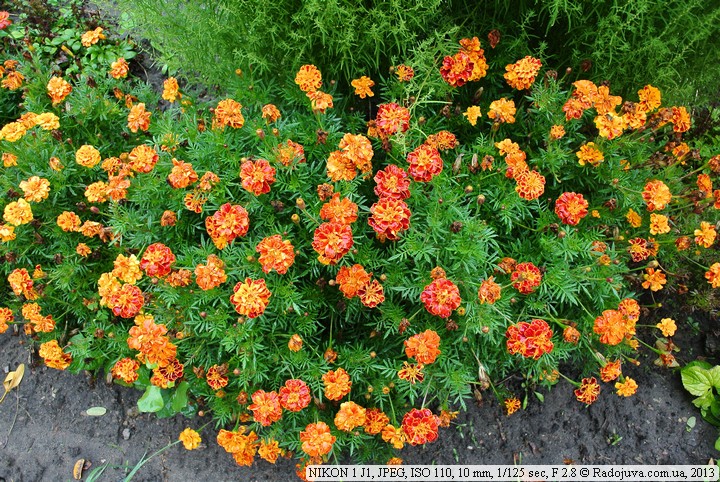
Photo at Nikon 1 J1
Camera prices
You can look at the real prices for the Nikon 1 J1 camera in popular online stores at the following links:
Prices for modern Nikon 1 cameras can be viewed here.
The exact list of system mirrorless cameras with interchangeable lenses Nikon 1:
- Nikon 1 J1, Nikon 1 J2, Nikon 1 J3, Nikon 1 J4, Nikon 1 J5.
- Nikon 1S1, Nikon 1S2
- Nikon 1 V1, Nikon 1 V2, Nikon 1 V3
- Nikon 1AW1
Comments on this post do not require registration. Anyone can leave a comment. Many different photographic equipment can be found on AliExpress.
How to configure?
People who buy such a camera usually want vibrant, vibrant, and sharp photos. To get them without unnecessary troubles, I advise you to configure the camera like this:
- Mode exposure - Auth. plot selection
- Image quality - Fine
- Image size - L
- Shooting Mode - Continuous
- Measurement exposure - Matrix
- White balance - Auto, or any other
- ISO sensitivity - A3200
- Picture Control - VI, enter this mode and set sharpness to '9'.
- Active D-lighting - On
- Reduce. noise / duration exp. - On
- Reduce. noise / high Chuv ISO - On
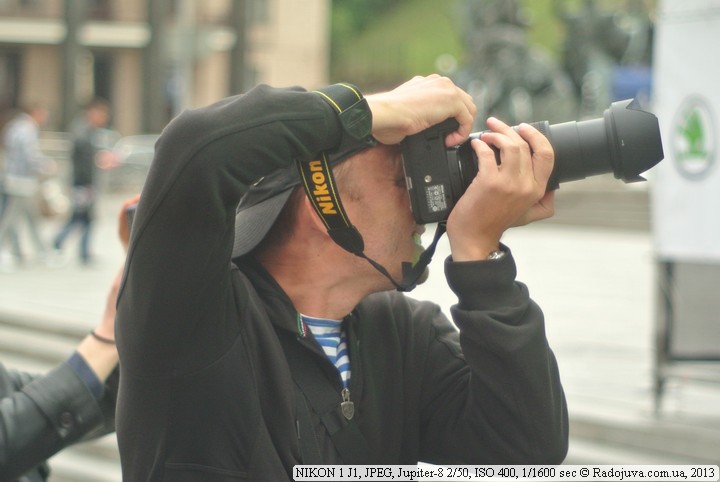
Photo at Nikon J1
Conclusions:
Nikon 1 J1 is one of the simplest cameras in the Nikon 1 line. The camera is very small and powerful: here you can shoot 60 photos in one second, and Full HD 60i (with slow motion), and a large frame buffer, and many other pleasant things. Such a camera is suitable for those who do not want to mess with large DSLRs, but want to get a fairly high-quality image and video.
In 2018, all Nikon 1 cameras were added to the archived products section of Nikon official websites.
Material prepared Arkady Shapoval. Training/Consultations | Youtube | Facebook | Instagram | Twitter | Telegram

















here
also - on the roof of a five-story building in the old center
view from the office
is there sharpness?
Of course there is, excellent harshness
Soap.
Few?
Hello. Gentlemen photographers, help out the teapot! I am the proud owner of a Nikon 1 V1 mirrorless mirror.
Congenital greed does not allow buying expensive original lenses for a “marching workhorse” that are cooler than a 10-30 set, and the hatred of marketers acquired along with a higher engineering education does not allow these constantly dying 10-30 to be purchased every six months.
In this regard, I want to stick something Soviet and iron naive to this building, naively believing that somehow I can cope with the lack of autofocus by acquiring a nice bokeh and color shades straight from a happy Soviet youth.
The problem is that there are a lot of manuals on the Internet for installing these "objects" on Nikon DSLRs with an "F" mount, but I just found out by the "Nikon 1" mount (aka CX) that there are such adapters. Please clarify this question, professionals?
What Soviet lenses will fit simply through an adapter without problems such as loss of focus to infinity? Which is best set as a regular landscape cat seal fifty dollars?
Maybe just not steamed and buy a pre-configured 44-m-let's say-7? Or find the same 81N and give it to someone in the setting? Or maybe I just misunderstood everything and he will just get up through the M42 ring to Nikon1?
through the M42 adapter to Nikon1, any lens with an M42 thread (81H does not apply to them) should stand up while maintaining infinity. Therefore, buy any Helios with M42 (not redone, but with a native working length) and enjoy
Thank you so much for the answer. =)
Well, it’s possible to enjoy it there, it’s all from poverty, and I perfectly understand that the same Helios will not give me normal quality, but it’s better to keep silent about the ease of use. Okay.
I’m a stubborn guy, so I continued to read the forums and
make shit out of candyI learned a bunch of other clever words and cunning brands of lenses in addition to the propelled helios.Dooooopustim there is an adapter from any existing mount to Nikon 1, excluding the expensive FT-1 and with preference to the notorious M42. Native Nikkors are no longer inexpensive, so I almost resigned myself to the manual nature of the future lens. The question is what exactly to look for so that you do not have to pretend that you are crazy about vintage "boke"?
Tasks - old, landscapes and cityscapes. Options - all Avito, Moscow and St. Petersburg. Super Takumar 55 mm 1,8 for example or Nikon's staff? Or is it a Soviet TV set like Jupiter?
When it comes to choosing lenses - the entire Arkady site to help :). If for landscapes, look at focal lengths from 35 mm (Mir-1, there are several reviews on Radozhiv), and a telephoto lens like Jupiter-37 will not be superfluous either, because very different focal lengths from 35-50 mm and a completely different range of tasks. In any case, if you find an old lens in good quality and at a normal price, you can sell it for about the same money, if you don’t like the focal length.
EGF: 35 * 2.7 = 94,5, 55 * 2,7 = 148,5, 135 * 2,7 = 364,5. What kind of landscapes?
I want to add to my piggy bank, so to speak, my experience. I have a Nikon 1 V1 .. and I also come across dying lenses, no criticism can stand their reliability. I found an alternative option - this is the Vega-7E 2/20 lens through the N1-C-mount adapter gets up like a native. Unfortunately, the exposure metering does not work, everything is by eye. But even though it's like completely without a lens
10 mm standard width - WITHOUT stabilization?
I have V1, suitable for reeling in the parks
And for a city (day / night) is such a lens suitable? (10-30)
norms for walking
for walks, I thought I needed legs, but I still don’t understand how the camera and walk
About the lens to nikon 1. Try the industrial 69 from seagull. There are 2.8 by 28. And the working segment is 27. This is, of course, also about 75 in the equivalent ... Well, you can also be smart with cameras.
Hello. Please advise. I have a Nikon D7200 mirror. It is not convenient to take with you everywhere.
I want to buy a system camera.
The layout is this:
Nikon J1 mileage 1.500 shots. Owner 6.000 rub.
Sony nex5 mileage 30.000 shots. The whole slurry, even the lens has traces of spray. I would have bought it, but I think they killed him in five years of negligent exploitation. 10.000 rub.
There are still Sony Nex 3. For 8.000
And Olympus or Samsung.
I do not know who has faster autofocus and cheaper diverged.
I will be glad to answer a professional.
I do not advise taking a unit from Nikon - the matrix and what it gives out is really not very good.
As for me, the Neks will be more interesting.
NEX is very good, third-party manual optics are easily used through an adapter. And 10000 for 5 with such a mileage is too much.
Olympus is more compact, lighter, a stabilizer on the matrix, a wide range of lenses. There are compact crunchy and inexpensive pancakes. For family photos on the street - the most it.
Thank you, Arkady, for the excellent review.
A friend sold an old D90 with whale glass and bought a Nikon 1 V3 with a pair of three glasses.
Now it is impossible to look at his pictures without tears.
D90 even in the green zone or P mode gave a much more sane result than this inch. In my opinion, the pancake came out lumpy - and matrices and glass are utter shit.
Against the background of mikra and glass, bad guys and no matrix. And the pictures are similar or even worse than the pictures on the 7th iPhone. I looked at the pictures on this camera and cameras with the same small matrix and realized that it was better for Nikon not to disgrace and remove this disgrace from the pr-va. It was better to try to unite with Olympus and Pornoslonik and give birth to your version under mikra. Glasses under this standard in bulk and no need to reinvent the wheel. You just need a matrix with good DD and tenacious AF.
Great review, thanks
I want to ask, there are lenses specially for the Nikon 1 series, in which, in addition to numbers, there are also letters, namely: AW, VR, PD-ZOOM. I would like to know what this means?
Nikon 1 Nikkor lenses (which total 13 models), there are only 3 of these additional markings:
VR — Vvibration Reduction - Vibration Reduction - Built-in Image Stabilizer that will allow you to use slower shutter speeds for blur-free shooting of stationary objects. This marking is also used for other Nikon lenses.
AW - All Weather - weatherproof lenses, in line Nikon 1 only two of these are fix Nikon 1 NIKKOR AW 10mm f / 2.8 and zoom Nikon 1 NIKKOR AW 11-27.5mm f / 3.5-5.6.
PD Zoom - Power Drive Zoom - lenses with a built-in motor for zooming. With these lenses, the focal length can be changed automatically instead of manually rotating the zoom ring. There are also only two such lenses - Nikon 1 NIKKOR VR 10-30mm f / 3.5-5.6 PD-ZOOM и Nikon 1 NIKKOR VR 10-100mm f / 4.5-5.6 PD-ZOOM.
I tried this kid (J2) in more detail. In general, I unexpectedly liked it, although, objectively, what could I like there? Small sensor with noisy small pixels? Or housewife's “all-in-car” ergonomics? (PASM switch was looking for 5 minutes, shame on me!)
But ... But! When developing raws in C1, it is often necessary to REDUCE the sharpness in a small minus. This is the first time I've seen such sharp glass (10-30 VR). Steeper than a minolta or pentax at half a crope, and for a zoom it is technically very difficult to achieve.
ISO 400 - ceiling. Picky and inevitable.
Metering focuses on shadows - making D-Lighting easier to work with, but killing highlights. With this in mind, shoot in RAW with a slight minus exposure compensation. However, if you need to shoot something at ISO 800+ - do plus correction - then press it in the editor (kill DD along with noise).
The lights are shitty, too small pixels fly into saturation when shooting, there’s nothing to restore information from.
BB is lying, makes acid-emerald greens, but on the gray card - excellent.
As a whole - a good toy.
Why do you have to if it is not software, but optical?)))))) I have never heard that the sharpness was a minus ..
Very handy camera for street photography in the city. Landscapes, portraits are not her strong point. But the street or just like a notebook for photographs - that's the thing. Examples of photos on Yandex https://yadi.sk/a/2EdIWotc3Thwm3.
Fuji has made a niche camera, which you can’t call a massive one! Are you ready to buy a small camera from Nikon for the price of D3? Then, as I said, Fuji did not have a line of its cameras that could suffer from the appearance of the X100. Sony made NEX and then they were afraid of it themselves. And let her cut functions - a lack of glass, a lousy menu, your shoe with an ugly flash, and so on. He also has his own NEX across his throat. Why is Nikon revolution? =:)
Who will tell you how you can repair a whale lens on your own.?
"The noise level of the Nikon J1 is comparable to the old Nikon D40, D70s SLR cameras (noise from ISO 200)"
Nonsense! Do not make noise on the ISO 200 Nikon D40, D70s
In fact, the noise is present, most likely you wanted to say that it is insignificant
With this approach, it turns out that all the cameras are noisy, but only slightly
In fact, just like that
The noise is part of the signal))), I bought this soap box for my wife to play, let the children take pictures in the sandbox
I have been using Nikon J3 kit 10-30 at home for the subject and macro for several years.
Having read on the Internet about the quality of DSLRs, I took the D5300 kit 18-55 plus Wave-9.
In the DSLR, the picture quality is much higher, no doubt. Yes, and better lenses.
But: the DOF of the DSLR turned out to be just scanty compared to Nikon 1. To make the field sharp, you need to clamp the aperture to F16 or more, there is little light.
Then the lens itself is thicker and longer, darkens the subject from the flash when shooting more.
In short, my DSLR is almost idle. Well, sometimes there is a desire to experiment with some Helios or Jupiter, bought on a flea market. And I continue to use the mirrorless mirror, it’s more convenient for me.
Now a correction to the article:
The 10-30mm VR lens is NOT a metal mount.
This is a very high-quality plastic, coated on top with a layer of metal spraying. In places of friction, a layer of shiny coating peels off and dark plastic emerges.
I don’t understand why everyone is scolding the “small” matrix. It is clear that not a DSLR and Nex, but in comparison with 1,27 and 1,8 it is very, very much.
Because this matrix and the entire system is an outsider. There are no normal glasses - one junk. Matrices in units are worse than Sonia thumbnails and an order of magnitude worse than micry4 / 3. Mikra4 / 3 represented by Pornoslonik and Olympus with their large park of lenses destroyed Nikon's Edinichka. This whole Nikon system turned out to be of no use to anyone - neither photographers nor videographers. Amateur teapots also seem to understand something and take cameras with a crop of 1.5-1.6.
Hello. Advise me a good macro camera for macros. I knit toys, there is a page on Instagram, but my old Nikon 1 J1 camera is very weak. Photos are obtained by rozimimi, a lot of gray. I want to buy a camera that you advise.
Any DSLR - mirrorless + macro lens. For macro, the camera is not that important.
optimal - chambers mikra, olika and panasonic with the possibility of stacking.
best of all, of course, the Olympus and the Panasonic macro lens 45mm or the 60mm macro.
big flu is very important for macro, and in this case a small micra matrix with crop 2.0 has all the advantages over crop 1.5,1.6 and FF.
take a ring flash in the kit.
Stacking for knitted toys? too much ...
stacking for macro. free feature in mirrorless Olympus. a long time ago.
What bi-vi was advised to me by a macro camera for beginners. My budget is 600-700 euros.
This will suit me
Olympus OM-D E-M10 MKIII Zilver 14-42mm F3.5-5.6 EZ + 40-150mm F4-5.6R
The camera will do. The lenses you specified are not intended for macro photography. Olympus needs something like Olympus 60mm 1: 2.8 Macro ED, Olympus 30mm 1: 3.5 ED Macro or from third party manufacturers with the appropriate mount, or something non-autofocus through an adapter. The main condition is a fixed lens (not a zoom) and the word Macro in the title is desirable.
The camera is excellent, it will do. and there the problem of the shock tent is solved.
There are only a few native lenses:
Olympus 60mm 1: 2.8 Macro ED - this will give you 120mm focal length
Panasonic Leica DG Macro-Elmarit 45mm f / 2.8 ASPH. MEGA OIS Lens - in terms of 90mm focal length.
Olympus M.Zuiko Digital ED 30mm f / 3.5 Macro - 60mm equivalent
Panasonic is smaller, lighter, more expensive, there is an optical stub (it makes no difference to you), Panasonic has better detail in the center, Olika has better detail over the entire frame area.
The Olympus M.Zuiko Digital ED 30mm f / 3.5 Macro is the cheapest, with 25% more magnification and may be the best choice for you. Its main disadvantage is that it should be placed too close to the object, which is critical if the object is moving or may get scared.
Arkady, I beg you to explain the reason why there is enough light, and ISO 100, and the face is grainy and unnatural. And this is in both cameras. Kenon 220 (soap box) and this photo is from Nikon 1J1. This is such a nedenichnaya photo. Often this happens on a smartphone too (in the shade under the trees)
Hard midday light - high contrast. The soap dish, along the way, begins to process the photo in order to get the details from the shadows (to draw the shadows), hence the graininess. Try to exclude bright illuminated areas in such photos should help)
Thank you, tomorrow if the forecast does not materialize and it will be sunny we will go to the same place with my wife and try to exclude the bright background.
“If I was faced with the choice of buying a camera with interchangeable lenses, then… .. instead of Nikon J1, I would have taken a simple, but more bulky DSLR camera Nikon D3100 with a whale lens.” - I also.
(in me buv dosvid, z nikon 1, і z d3100. If you want, you can shoot a single one from 50mm - 135mm, and you can drink a lot of old camera cameras, that .. don't cook it. has grown up ”d3100 - well, let’s say є, in all parameters .. navit, for an hour sattі written)